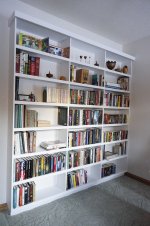I'm trying to figure out the best way to build long runs (~12') of library-style bookcases with fixed shelves to line all 4 walls of a room (out of 3/4 ply plus solid wood face frames / edge-banding with each book "bay" ~36" wide). Obviously the standard way to do this would be just to build the individual cases and join them together, but I really don't like the look of the doubled vertical supports. Frank Howarth accomplished something similar by putting the joint in the middle of each book bay and using shelf pins.
What I'm curious about is if the Domino might help solve this problem for me. I'd prefer to have the shelves fixed instead of using pins. I was basically wondering if I could just use floating tenons on each side of the single verticals to hold the selves and then assemble them in place. In fact, would it even be possible to cut the mortise all the way through and have a long Domino sticking out on both sides of a single vertical support to support shelves on each side of that vertical?
I thought about maybe trying to do sliding tapered dovetails, but (1) I'm worried I'd weaken a 3/4" vertical too much with dovetails cut on each side and (2) it would be a heck of a lot of work to cut and fit all those shelves. Is a Domino the solution I need to just get this done, or am I barking up the wrong tree? (I don't have one yet, but I've been lusting after one for a while and I'm willing buy a 500 if it would make doing this as efficient as it seems like it might).
Any thoughts / suggestions would be appreciated. Thanks
(I'm new here and did some searching already but wasn't able to find my exact question addressed in other threads.)
What I'm curious about is if the Domino might help solve this problem for me. I'd prefer to have the shelves fixed instead of using pins. I was basically wondering if I could just use floating tenons on each side of the single verticals to hold the selves and then assemble them in place. In fact, would it even be possible to cut the mortise all the way through and have a long Domino sticking out on both sides of a single vertical support to support shelves on each side of that vertical?
I thought about maybe trying to do sliding tapered dovetails, but (1) I'm worried I'd weaken a 3/4" vertical too much with dovetails cut on each side and (2) it would be a heck of a lot of work to cut and fit all those shelves. Is a Domino the solution I need to just get this done, or am I barking up the wrong tree? (I don't have one yet, but I've been lusting after one for a while and I'm willing buy a 500 if it would make doing this as efficient as it seems like it might).
Any thoughts / suggestions would be appreciated. Thanks
(I'm new here and did some searching already but wasn't able to find my exact question addressed in other threads.)

